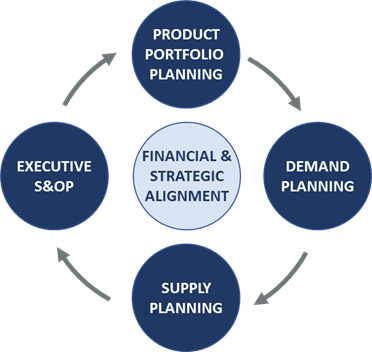
Most superhero stories like Superman and Batman, follow a similar script. First, the protagonist of the story is introduced along with her or his superhero powers and ambition to make the world a better place. Then the villain comes in who has a different plan that threatens humanity. In an epic fight, the villain is defeated, the world is saved, and the hero gets praise.
There are many similarities in how many supply chains tend to be managed. The supply chain leader is the protagonist that needs to deliver operational performance. Then a crisis occurs that is solved by applying a short-term crisis management approach. These supply chain leaders get rewarded and praised as they have saved customer performance, lowered inventory, etcetera.
Crisis management is necessary as both on-demand and supply-side unexpected events occur frequently. However, the culture in many organizations fosters firefighting, hardly leaving any attention to solving root causes and looking beyond the short-term horizon. It also lacks rewarding people who prevent problems.
How do create more focus on the mid-term and prevent issues? What are the levers that organizations need to pull? How does problem prevention get a similar status as the problem solvers?
From reactive to pro-active planning
Sales & Operations Planning (S&OP) is the process that focuses on preventing problems. It aims to make tactical business decisions to mitigate risks and leverage opportunities before they take effect and evaluate the different options to reduce the impact of existing constraints. The key advantage of a proactive planning approach is that it provides flexibility by increasing the number of options organizations have to deal with risks and opportunities more effectively and efficiently.

S&OP focuses on balancing revenue, costs, and working capital. It consists of a cycle of 4 processes that pro-active answer key questions:
- Product portfolio planning: Do we have the right product portfolio to meet our targets?
- Demand planning: How much are we planning to sell and does this match our ambition?
- Supply planning: Do we have the right inventory, capacity, and capabilities to meet demand?
- Executive S&OP: What decisions do we need to take to close the gaps between plan and ambition? What are the (financial) consequences of the choices we make?
Though S&OP might sound rather straightforward, many organizations are struggling to successfully deploy it and realize the benefits. According to research from Supply Chain Insights, only 35% of supply chain leaders indicate that their S&OP process is effective1. Organizations should work on a number of actions to create engagement, realize the impact, and become the new heroes of the supply chain.
Build a solid business case and explain the benefits
S&OP is complex and often not well understood. People don’t know what it is, what is expected of them, and what are the benefits to them and the organization. This impacts the level of support and with that the chances of success of S&OP.
Supply chain leaders should start engaging key executive stakeholders by explaining the quantitative benefits of S&OP for the business. A business case needs to be build built that addresses operational benefits. The main operational KPIs that are impacted by S&OP is higher forecast accuracy, better service (On-Time-In-Full), shorter lead/cycle times, better asset utilization, reduced inventory levels, and inventory turns, improved planner productivity, and transportation spend. In alignment with finance, these benefits should be translated into business benefits like top-line growth, margin improvement, and return on invested capital. Reported improvements through S&OP are significant, some studies2 and case studies indicate 5-30% improvement on individual KPIs but are dependent on the baseline performance.
The qualitative benefits of S&OP for the different functions should be explained as well. Focus on how S&OP will make the lives of the different (functional) stakeholders easier and will help them achieve their goals. For example, explain to sales leaders that product availability will improve, manual sales planning activities could be automated and new customer insights might be obtained from planning data.
Redesign the process around functional alignment
Usually different functional planning processes are in place in an organization, for example, marketing planning, sales planning, procurement planning, and financial planning. If these planning cycles are disconnected, this might lead to functional optimization.
Focus on connecting these functional planning cycles rather than replacing existing planning processes. In alignment with the different functional stakeholders, streamline the processes and timing to fit in the S&OP cycle. Define business value drivers, key business decisions to be taken and by whom, required information for decision making, and roles & responsibilities.
Companies should prevent S&OP from becoming an additional cycle with additional meetings and workload. For example, merge the Monthly Business Review (MBR) meeting and executive S&OP meeting into one meeting instead of having two different meetings with misaligned information. Planning software can further support process orchestration to coordinate all the activities of the multiple areas like creating, assigning actions, and notifying users as well as collaborating on a common plan.
Improve information quality
Many S&OP processes get derailed by a lack of trust in the plan. Very often S&OP meetings are captured by a discussion about data quality which results in. As a consequence, decisions are based on emotions and assumptions rather than facts. This will impact the decision quality and the credibility of S&OP.
Improving decision-making quality starts with high-quality information. Use a planning system to create baseline plans with statistical models and algorithms instead of using human judgment. Enrich the plans with planners and key stakeholder insights. Forecast value adds (FVA) is a good metric to measure the positive and negative effects of adjusting plans by planners.
The outcome quality of a planning platform is as good as its inputs and the model it uses. Significant time should be spent on improving the quality of (master) data and defining the right parameters for the model, e.g. market drivers and supply constraints.
To take a decision there need to be choices. Define the risks and opportunities that need to be considered what are the different options and financial impacts. This will make the decision-making process more objective.
Communicate benefits and success stories
The impact of S&OP decisions on performance is big but is less visible than in crisis management. The time between decision and impact is typically long and people have a short attention span. This might take away the attention from S&OP and focus back to the short-term firefighting.
Measuring the impact of planning decisions on business results is the starting point for keeping the momentum. Evaluating decisions and showing the impact on key KPIs will provide proof that the business case for S&OP is realistic. Setting up dashboards that track the key supply chain and business KPIs will help companies “see and understand” the quantitative impact. Success stories of S&OP should be shared in the organization to also make the qualitative case for S&OP more tangible.
S&OP hero…. no superpowers required
It requires a blend of processes design, technology adoption, and change management to get a successful S&OP process. The magic word is showing the impact on business performance. Becoming a hero with S&OP doesn’t require superpowers but requires perseverance and disciple to change behavior and culture.
 Bio: Peter Schram – independent advisor (ex-Gartner analyst)
Bio: Peter Schram – independent advisor (ex-Gartner analyst)
Peter Schram works as an independent adviser at Breakthrough Advisory, a firm he recently founded. Breakthrough Advisory helps organizations deliver business results by unlocking the full potential of operational, tactical, and strategic planning. Peter combines deep supply chain knowledge with practical, hands-on supply chain transformation management experience. He has almost 20 years of experience in consulting, research, and industry roles working for leading organizations like Gartner, Philips/Signify, Paccar/DAF Trucks Accenture, and IG&H consulting. He has a broad international experience in supporting Fortune 500 companies in multiple industries including manufacturing, CPG, healthcare, aerospace, energy and utilities, and high-tech.



